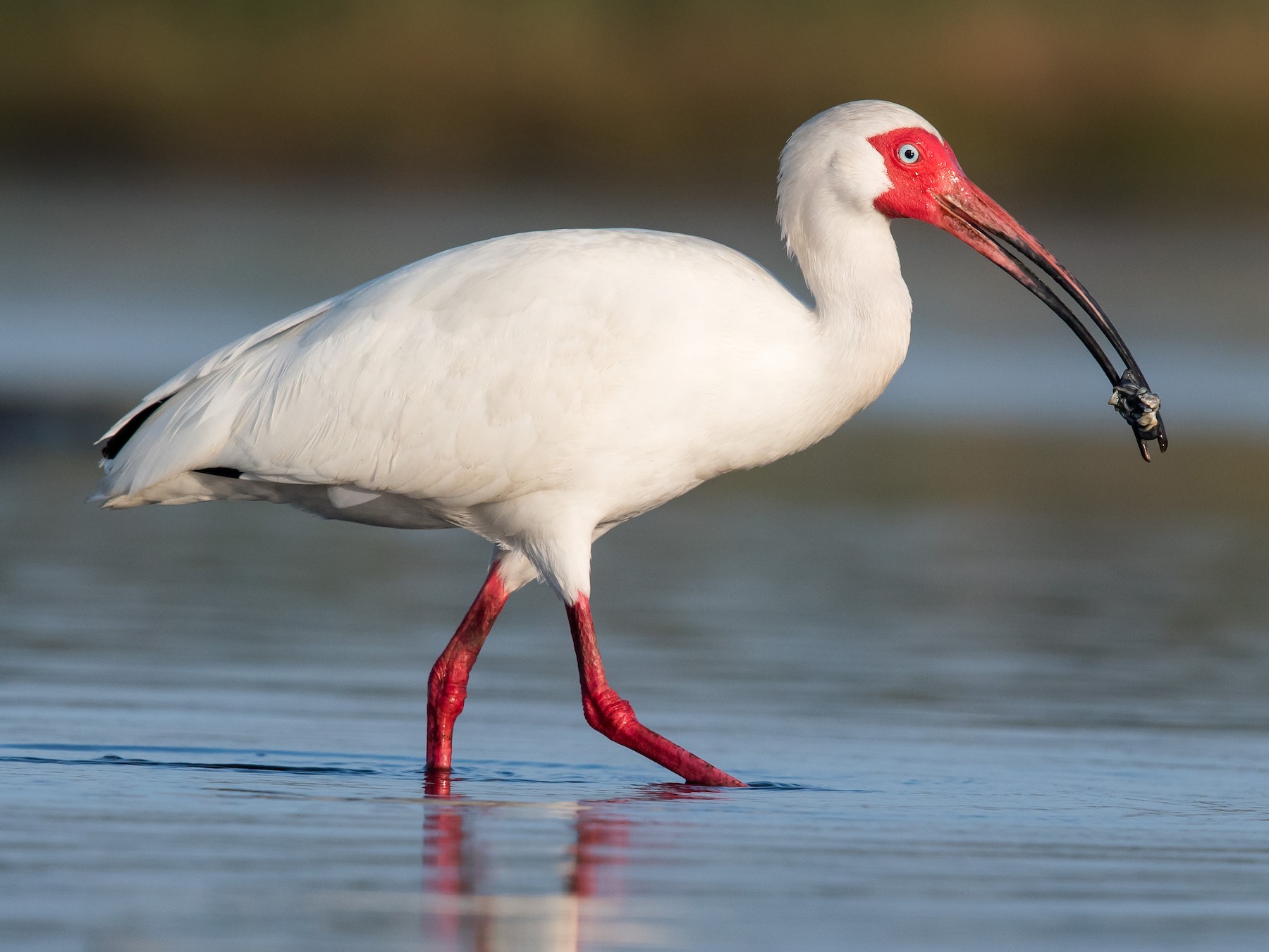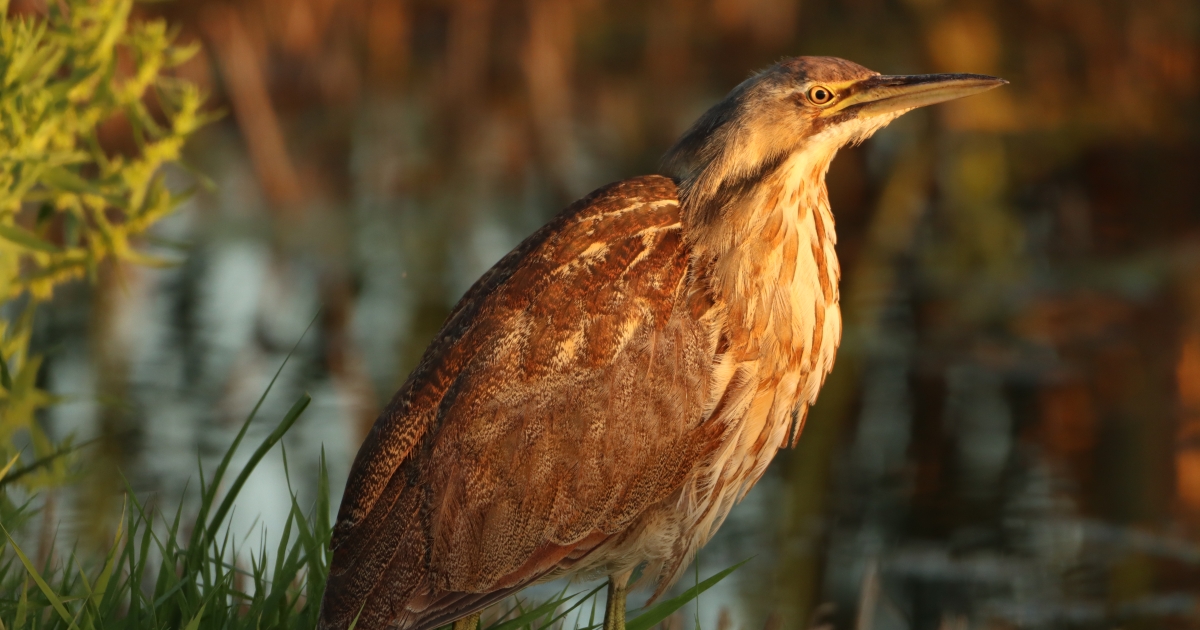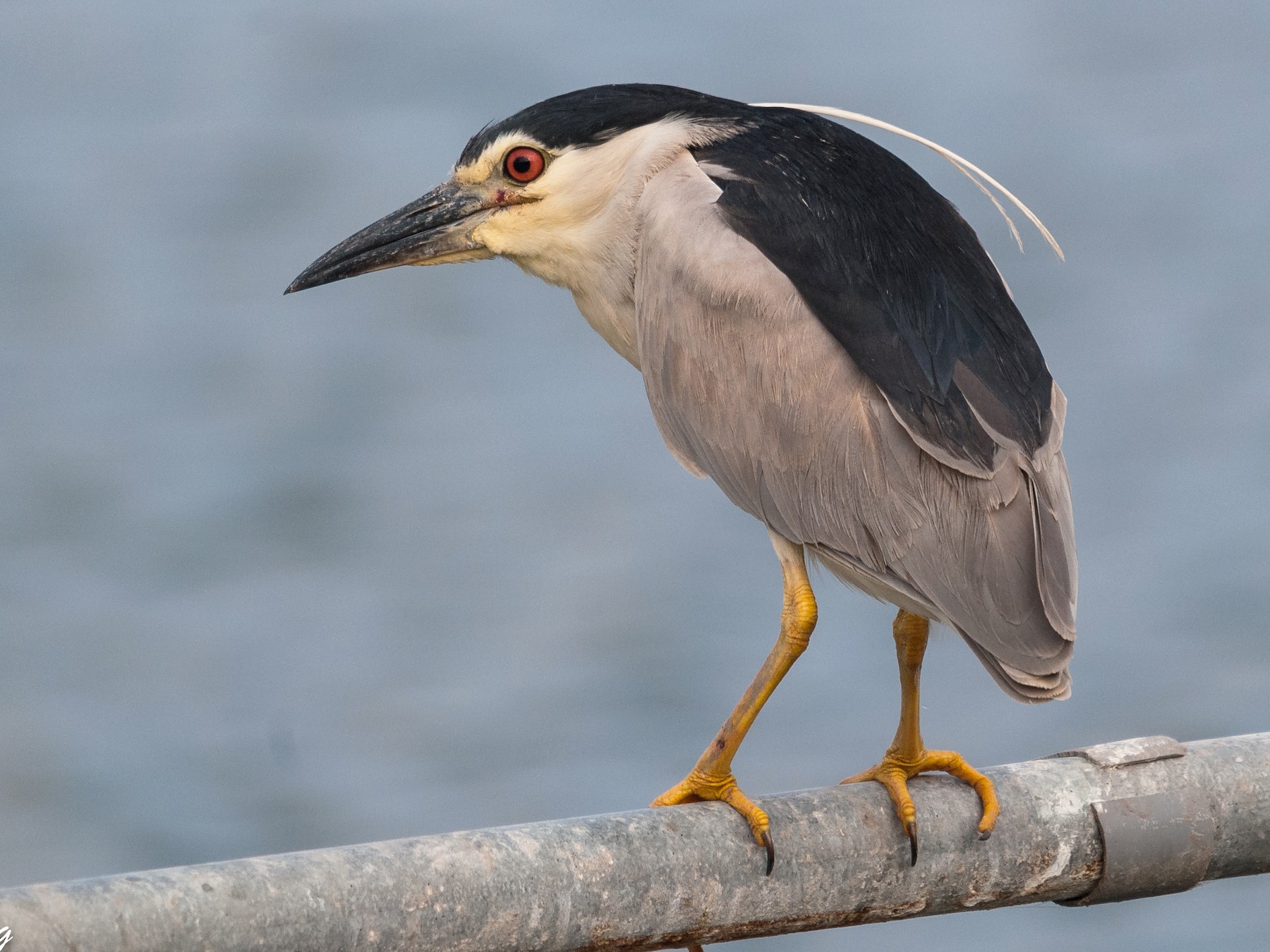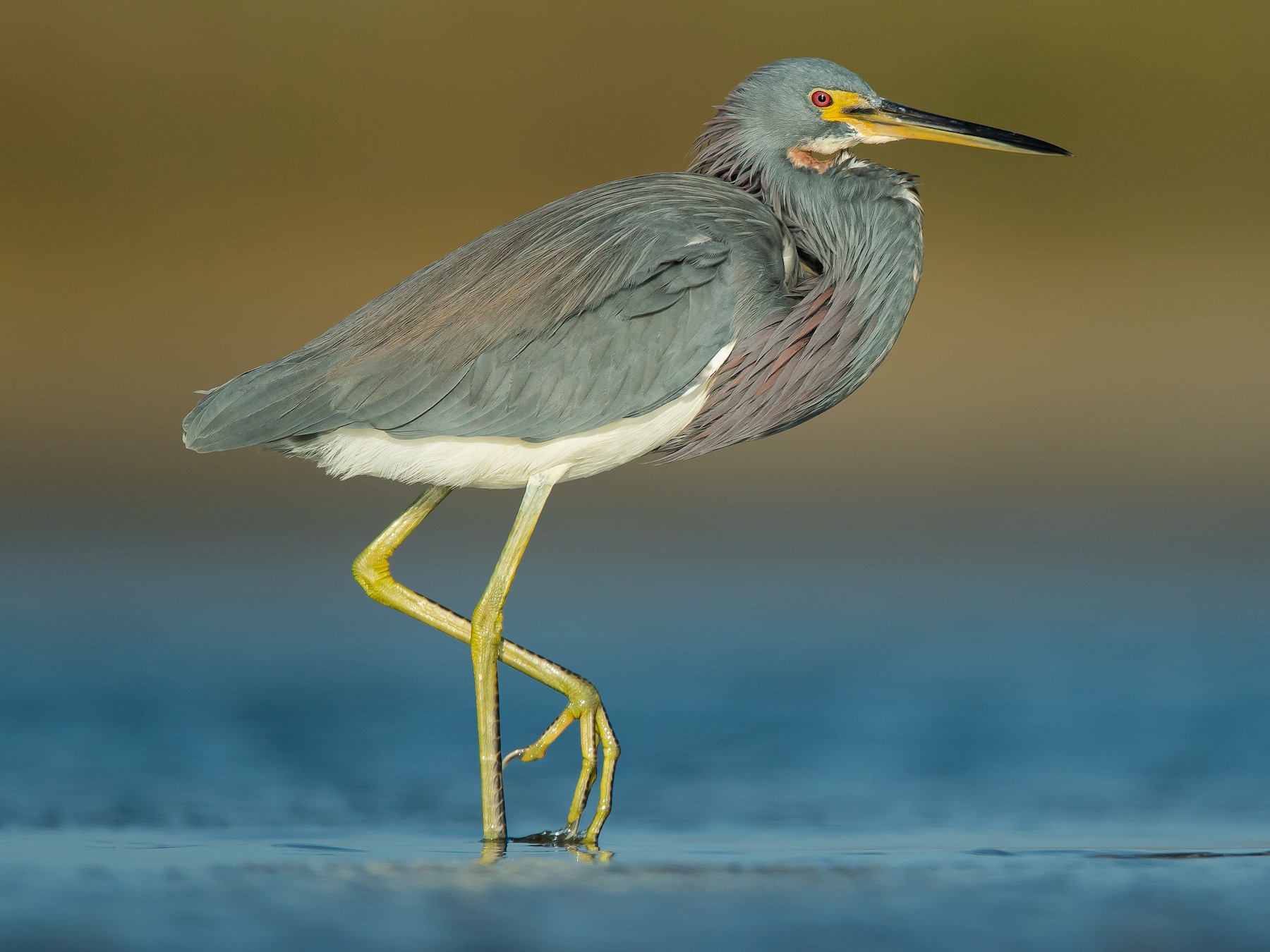Heron birds are fascinating creatures that are commonly found in wetland habitats across North America. These graceful aquatic birds are thrilling to watch as they carefully move through vegetation and shallow water. However, it can be challenging to tell them apart due to their similar appearances.
In this article, we will discover 12 types of heron birds and learn how to identify them by appearance, habitat, nest location, and calls. We will also explore their characteristics, types, habitat, diet, and frequently asked questions.
You are reading: 12 Types Of Heron Birds

12 Types Of Heron Birds
American Bitter

The American Bittern (Botaurus lentiginosus) is a medium-sized wading bird that is part of the heron family. It is mostly warm brown, buff, and white, with strong streaks, especially on the neck.
The American Bittern is a solitary bird and is usually well-hidden, making it difficult to observe. It is mainly nocturnal and is most active at dusk.
The American Bittern is known for its distinctive booming, clacking, and gulping calls, which have earned it some colorful nicknames, including “stake-driver” and “thunder-pumper”. It is found in extensive freshwater marshes, where it feeds on fish, amphibians, reptiles, small mammals, crustaceans, and insects.
The American Bittern is 23-34 inches in length with a wingspan of three feet.
Black-crowned Night-Heron

The Black-crowned Night-Heron (Nycticorax nycticorax) is a medium-sized heron found throughout a large part of the world, including parts of Europe, Asia, and North and South America.
It is a stocky bird with a thick neck, large flat head, and heavy, pointed bill. The legs are short, and the wings are broad and rounded. Adults have a black crown and back with the remainder of the body white or gray, red eyes, and short yellow legs. They have pale gray wings and white underparts.
Two or three long white plumes, erected in greeting and courtship displays, extend from the back of the head. The sexes are similar in appearance, although the males are slightly larger.
Black-crowned Night-Herons are most active at night or at dusk, when they do most of their feeding. They spend much of the day hunched among leaves and branches at the water’s edge.
They are common in wetlands across North America, and they usually breed in colonies, of this species alone or mixed with other herons, egrets, ibises, sometimes with Franklin’s Gulls.
Read more : Bees Are Taking Over My Hummingbird Feeder
Black-crowned Night-Herons are affected by a number of threats across their annual cycle, including wetland loss and water pollution.
Cattle Egret
The Cattle Egret (Bubulcus ibis) is a small, compact white heron that is native to Africa but has spread to many parts of the world, including the Americas, Europe, and Asia.
Here are some key facts about the Cattle Egret:
Appearance:
– Adult Cattle Egrets are all white with a yellow bill and legs.
– In breeding plumage, they have golden plumes on their head, chest, and back.
– Juveniles have dark bills and legs and lack the golden plumes.
Habitat:
– Cattle Egrets are found in a variety of open habitats, including fields, pastures, plowed fields, lawns, roadsides, and marshes.
– They often associate with grazing animals, such as cattle, horses, elephants, and camels, to forage for insects that are flushed out by the animals.
Diet:
– Cattle Egrets feed mainly on insects, especially grasshoppers, crickets, and flies.
– They also eat spiders, snails, and small vertebrates, such as frogs and lizards.
Behavior:
– Cattle Egrets are usually seen in flocks, especially during the non-breeding season.
– They forage on the ground, often in association with grazing animals.
– They also follow tractors or lawnmowers to catch insects that are disturbed by the machinery.
Conservation:
– Cattle Egrets are not considered threatened, and their populations are stable.
– They are sometimes considered pests because they can damage crops and spread disease.
– However, they are also valued by farmers for their role in controlling cattle parasites, such as ticks and flies.
Overall, the Cattle Egret is a fascinating bird that has adapted well to living in close association with humans and domestic animals.
Glossy Ibis
The Glossy Ibis (Plegadis falcinellus) is a water bird that belongs to the ibis and spoonbill family Threskiornithidae. Here are some key facts about the Glossy Ibis:
Appearance:
– At a distance, Glossy Ibises look uniformly dark, but a close look in good light reveals stunning colors: deep maroon, emerald, bronze, and violet.
– They have dark purple to black feathers on their head, neck, back, and belly.
– Their legs are long and black, and their wings and tail are a shiny green.
– They have a very thin white border surrounding the dark facial skin and dark eyes.
Habitat:
– Glossy Ibises are found in a variety of wetland habitats, including freshwater and saltwater marshes, swamps, and shallow wetlands.
– They are less commonly found in coastal locations such as estuaries, deltas, salt marshes, and coastal lagoons.
– They prefer roosting sites in large trees that may be distant from the feeding areas.
Diet:
– The diet of the Glossy Ibis is variable according to the season and is very dependent on what is available.
– Prey includes adult and larval insects such as aquatic beetles, dragonflies, damselflies, grasshoppers, crickets, flies, and caddisflies, Annelida including leeches, mollusks (e.g., snails and mussels), crustaceans (e.g., crabs and crayfish), and occasionally fish, amphibians, lizards, small snakes, and nestling birds.
Behavior:
– Glossy Ibises are usually gregarious and are found in flocks.
– They are unmistakable in flight, with their long, down-curved bills and long, outstretched necks.
– They are known for their distinctive guttural calls.
Conservation:
– Glossy Ibises are not considered threatened, and their populations are stable.
– They are sometimes hunted for food or sport in some parts of the world.
– They are also affected by habitat loss and degradation, especially in their wintering grounds.
Overall, the Glossy Ibis is a beautiful and adaptable bird that is found in a variety of wetland habitats across the world.
Great Blue Heron
The Great Blue Heron (Ardea herodias) is a large wading bird that is common near the shores of open water and in wetlands over most of North and Central America, as well as far northwestern South America, the Caribbean, and the Galápagos. Here are some key facts about the Great Blue Heron:
Appearance:
– The Great Blue Heron is the largest heron native to North America.
– It has blue-gray plumage on its upperparts and white on its face, neck, and underparts.
– It has a long, pointed yellow bill and long legs that are gray or black.
– It has a wingspan of up to six feet and can stand up to four feet tall.
Habitat:
– Great Blue Herons are found in a variety of wetland habitats, including freshwater and saltwater marshes, swamps, and shallow wetlands.
– They are also found in meadows, farmland, and other open fields.
– They nest in trees or shrubs near water, sometimes on the ground in areas free of predators.
Diet:
– The diet of the Great Blue Heron is highly variable and adaptable.
– They eat mostly fish, but also frogs, salamanders, turtles, snakes, insects, rodents, and birds.
– They forage by standing still or wading slowly in shallow water, waiting for prey to come within striking distance.
Behavior:
– Great Blue Herons are usually solitary and are often seen standing motionless as they scan for prey.
– They are also known for their slow, deep wingbeats and massive silhouettes in flight.
– They are long-lived birds, with some individuals living up to 15 years or more.
Conservation:
– Great Blue Herons are not considered threatened, and their populations are stable.
– They are protected under the Migratory Bird Treaty Act of 1918.
– They are sometimes affected by habitat loss and degradation, especially in their wintering grounds.
Overall, the Great Blue Heron is a majestic and adaptable bird that is found in a variety of wetland habitats across North and Central America.
Great Egret
The Great Egret (Ardea alba) is a large, elegant, and widely distributed egret that belongs to the heron family, Ardeidae. Here are some key facts about the Great Egret:
Appearance:
– The Great Egret is a tall, stately white wader with a long, S-shaped neck and a wingspan of up to five feet.
– It has black legs and a yellow bill.
– During breeding season, it grows long, delicate plumes on its back that curl over its tail.
Habitat:
– Great Egrets are found in a variety of wetland habitats, including freshwater and saltwater marshes, swamps, and shallow wetlands.
– They are also found in meadows, farmland, and other open fields.
– They nest in trees or shrubs near water, sometimes in colonies close to other wading birds.
Diet:
– The diet of the Great Egret is highly variable and adaptable.
– They eat mostly fish, but also frogs, salamanders, turtles, snakes, insects, rodents, and birds.
– They forage by standing still or wading slowly in shallow water, waiting for prey to come within striking distance.
Behavior:
– Great Egrets are usually solitary and are often seen standing motionless as they scan for prey.
– They are also known for their slow, deep wingbeats and massive silhouettes in flight.
– They are long-lived birds, with some individuals living up to 22 years or more.
Conservation:
– Great Egrets are not considered threatened, and their populations are stable.
– They are protected under the Migratory Bird Treaty Act of 1918.
– They were nearly wiped out in the United States in the late 1800s and early 1900s due to hunting for their feathers, which were used in the fashion industry.
Overall, the Great Egret is a majestic and adaptable bird that is found in a variety of wetland habitats across the world.
Green Heron
The Green Heron (Butorides virescens) is a small heron that is native to North and Central America. Here are some key facts about the Green Heron:
Appearance:
– Green Herons are short and stocky, with relatively short legs and thick necks that are often drawn up against their bodies.
– They have broad, rounded wings and a long, dagger-like bill.
– They have a dark greenish-blue back, a rich chestnut body, and a dark cap that is often raised into a short crest.
Habitat:
– Green Herons are found in a variety of wetland habitats, including freshwater and saltwater marshes, swamps, and shallow wetlands.
– They are also found in meadows, farmland, and other open fields.
– They nest in trees or shrubs near water, sometimes in colonies close to other wading birds.
Diet:
– The diet of the Green Heron is highly variable and adaptable.
– They eat mostly fish, but also frogs, salamanders, turtles, snakes, insects, rodents, and birds.
– They forage by standing still or wading slowly in shallow water, waiting for prey to come within striking distance.
Behavior:
– Green Herons are usually solitary and are often seen standing motionless as they scan for prey.
– They are also known for their slow, deep wingbeats and massive silhouettes in flight.
– They sometimes lure in fish using small items such as twigs or insects as bait.
Conservation:
– Green Herons are not considered threatened, and their populations are stable.
– They are protected under the Migratory Bird Treaty Act of 1918.
– They are sometimes affected by habitat loss and degradation, especially in their wintering grounds.
Overall, the Green Heron is a fascinating and adaptable bird that is found in a variety of wetland habitats across North and Central America.
Little Blue Heron
The Little Blue Heron (Egretta caerulea) is a small heron that is native to North and Central America. Here are some key facts about the Little Blue Heron:
Appearance:
– The Little Blue Heron is a small, darkly colored heron with a two-toned bill.
– Juveniles are entirely white, bearing resemblance to the snowy egret.
– During the breeding season, adults develop different coloration on the head, legs, and feet.
Habitat:
– Little Blue Herons are found in a variety of wetland habitats, including freshwater and saltwater marshes, swamps, and shallow wetlands.
– They are also found in meadows, farmland, and other open fields.
– They nest in trees or shrubs near water, sometimes in colonies close to other wading birds.
Diet:
– The diet of the Little Blue Heron is highly variable and adaptable.
– They eat mostly fish, but also frogs, salamanders, turtles, snakes, insects, rodents, and birds.
– They forage by standing still or wading slowly in shallow water, waiting for prey to come within striking distance.
Behavior:
– Little Blue Herons are usually solitary and are often seen standing motionless as they scan for prey.
– They are also known for their slow, deep wingbeats and massive silhouettes in flight.
– They are long-lived birds, with some individuals living up to 17 years or more.
Conservation:
– Little Blue Herons are not considered threatened, and their populations are stable.
– They are protected under the Migratory Bird Treaty Act of 1918.
– They were once hunted for their feathers, which were used in the fashion industry.
Overall, the Little Blue Heron is a fascinating and adaptable bird that is found in a variety of wetland habitats across North and Central America.
Snowy Egret
The Snowy Egret (Egretta thula) is a small white heron that is native to North and Central America. Here are some key facts about the Snowy Egret:
Appearance:
– The Snowy Egret is a slender heron with immaculate white plumage, black legs, and brilliant yellow feet.
– It has a black bill and a yellow patch of skin around its eyes.
– During the breeding season, adults grow filmy, curving plumes that once fetched astronomical prices in the fashion industry, endangering the species.
Habitat:
– Snowy Egrets are found in a variety of wetland habitats, including freshwater and saltwater marshes, swamps, and shallow wetlands.
– They are also found in meadows, farmland, and other open fields.
– They nest in trees or shrubs near water, sometimes in colonies close to other wading birds.
Diet:
– The diet of the Snowy Egret is highly variable and adaptable.
– They eat mostly fish, but also frogs, salamanders, turtles, snakes, insects, rodents, and birds.
– They forage by standing still or wading slowly in shallow water, waiting for prey to come within striking distance.
Behavior:
– Snowy Egrets are usually solitary and are often seen standing motionless as they scan for prey.
– They are also known for their slow, deep wingbeats and massive silhouettes in flight.
– They are long-lived birds, with some individuals living up to 17 years or more.
Conservation:
– Snowy Egrets are not considered threatened, and their populations are stable.
– They are protected under the Migratory Bird Treaty Act of 1918.
– They were once hunted for their feathers, which were used in the fashion industry.
Read more : How Often Should I Change My Birds Food
Overall, the Snowy Egret is a beautiful and adaptable bird that is found in a variety of wetland habitats across North and Central America.
Tricolored Heron

The Tricolored Heron (Egretta tricolor) is a medium-sized heron that is native to coastal parts of the Americas. Here are some key facts about the Tricolored Heron:
Appearance:
– The Tricolored Heron is a sleek and slender heron adorned in blue-gray, lavender, and white.
– It has a white stripe down the middle of its sinuous neck and its white underparts contrast with its dark blue-gray back and wings.
– It has a long, thin bill that is yellow with a black tip.
Habitat:
– Tricolored Herons are found in a variety of wetland habitats, including saltwater and freshwater marshes, mangroves, and swamps.
– They are also found in coastal lagoons, tidal creeks, and mudflats.
– They nest in colonies in trees or shrubs near water.
Diet:
– The diet of the Tricolored Heron consists mainly of small fish, but also includes crustaceans, insects, and other small aquatic animals.
– They forage by standing still or wading slowly in shallow water, waiting for prey to come within striking distance.
Behavior:
– Tricolored Herons are usually solitary and are often seen standing motionless as they scan for prey.
– They are also known for their slow, deep wingbeats and massive silhouettes in flight.
– They are long-lived birds, with some individuals living up to 17 years or more.
Conservation:
– Tricolored Herons are not considered threatened, and their populations are stable.
– They are protected under the Migratory Bird Treaty Act of 1918.
– They are sometimes affected by habitat loss and degradation, especially in their wintering grounds.
Overall, the Tricolored Heron is a beautiful and adaptable bird that is found in a variety of wetland habitats across the Americas.
White Ibis
The White Ibis (Eudocimus albus) is a medium-sized wading bird that is native to the coastal regions of southeastern North America, from Virginia to the Gulf Coast of the United States and south through most of the coastal New World tropics. Here are some key facts about the White Ibis:
Appearance:
– The White Ibis is almost entirely white, with black-tipped wings and a bright red-orange down-curved bill.
– It has long, thin legs that are pinkish-red, and bright blue eyes.
– Juvenile White Ibises are half brown and half white.
Habitat:
– White Ibises are found in a variety of wetland habitats, including freshwater and saltwater marshes, swamps, and shallow wetlands.
– They are also found in meadows, farmland, and other open fields.
– They nest in trees or shrubs near water, sometimes in colonies close to other wading birds.
Diet:
– The diet of the White Ibis consists mainly of small aquatic animals, such as fish, crustaceans, and insects.
– They forage by walking slowly in shallow water, sweeping their bill from side to side and probing at the bottom.
– They also forage on land, especially on mud or in short grass, finding food by touch while probing and by sight at other times.
Behavior:
– White Ibises are highly sociable birds that roost and feed in flocks at all seasons.
– They may steal food from each other and, in turn, have food stolen from them by larger species.
– They are long-lived birds, with some individuals living up to 16 years or more.
Conservation:
– White Ibises are not considered threatened, and their populations are stable.
– They are protected under the Migratory Bird Treaty Act of 1918.
– They are sometimes affected by habitat loss and degradation, especially in their wintering grounds.
Overall, the White Ibis is a beautiful and adaptable bird that is found in a variety of wetland habitats across southeastern North America.
Yellow-crowned Night-Heron
The Yellow-crowned Night-Heron (Nyctanassa violacea) is a small heron that is native to the Americas. Here are some key facts about the Yellow-crowned Night-Heron:
Appearance:
– The Yellow-crowned Night-Heron is a stocky heron with a short neck and legs.
– It has a smooth purple-gray body, a black-and-white face, and long yellow plumes on its head and neck.
– It has a long, thick, yellow bill that is slightly curved.
Habitat:
– Yellow-crowned Night-Herons are found in a variety of wetland habitats, including saltwater and freshwater marshes, mangroves, and swamps.
– They are also found in coastal lagoons, tidal creeks, and mudflats.
– They nest in trees or shrubs near water, sometimes in colonies close to other wading birds.
Diet:
– The diet of the Yellow-crowned Night-Heron consists mainly of small aquatic animals, such as fish, crustaceans, and insects.
– They forage by walking slowly in shallow water, waiting for prey to come within striking distance.
– They also forage on land, especially on mud or in short grass, finding food by touch while probing and by sight at other times.
Behavior:
– Yellow-crowned Night-Herons are usually solitary and are often seen standing motionless as they scan for prey.
– They are also known for their slow, deep wingbeats and massive silhouettes in flight.
– They are long-lived birds, with some individuals living up to 17 years or more.
Conservation:
– Yellow-crowned Night-Herons are not considered threatened, and their populations are stable.
– They are protected under the Migratory Bird Treaty Act of 1918.
– They are sometimes affected by habitat loss and degradation, especially in their wintering grounds.
Overall, the Yellow-crowned Night-Heron is a beautiful and adaptable bird that is found in a variety of wetland habitats across the Americas.
FAQS
1. What are the 12 types of heron birds?
The 12 types of heron birds are Great Blue Heron, Little Blue Heron, American Bittern, Black-crowned Night-Heron, Green Heron, Cattle Egret, Great Egret, Glossy Ibis, Snowy Egret, Tricolored Heron, White Ibis, and Yellow-crowned Night-Heron.
2. Where are heron birds found?
Heron birds are found in a variety of wetland habitats, including freshwater and saltwater marshes, swamps, and shallow wetlands. They are also found in meadows, farmland, and other open fields.
3. What do heron birds eat?
Heron birds eat a variety of small aquatic animals, such as fish, crustaceans, and insects. They forage by standing still or wading slowly in shallow water, waiting for prey to come within striking distance.
4. How can I identify different types of heron birds?
Different types of heron birds can be identified by their appearance, habitat, nest location, and calls. For example, the Great Blue Heron is a large blue-gray heron with a long, S-shaped neck and a wingspan of up to six feet, while the Little Blue Heron is a small darkly colored heron with a two-toned bill.
5. Are heron birds threatened or protected?
Most heron birds are not considered threatened, and their populations are stable. They are protected under the Migratory Bird Treaty Act of 1918.
6. How long do heron birds live?
Heron birds are long-lived, with some individuals living up to 15-22 years or more, depending on the species.
7. Do heron birds migrate?
Some heron birds migrate to warmer areas during the winter, while others are year-round residents in their habitats. For example, the Great Blue Heron is a year-round resident throughout most of the United States, while populations that breed in northern areas migrate to Mexico for winter.
Source: https://petstutorial.com
Category: Birds










